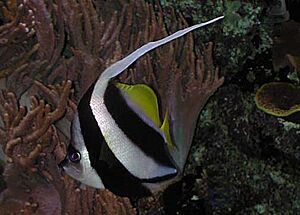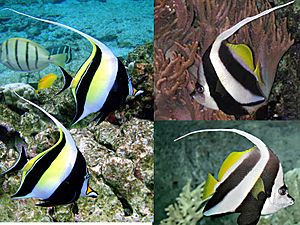Schooling bannerfish facts for kids
Quick facts for kids Schooling bannerfish |
|
|---|---|
 |
|
| Conservation status | |
| Scientific classification |
The schooling bannerfish (Heniochus diphreutes), also known as the false moorish idol, is a type of ray-finned fish that lives in the ocean. It is a member of the butterflyfish family, called Chaetodontidae. This fish is found in the warm waters of the Indo-Pacific area.
Contents
What Does the Schooling Bannerfish Look Like?

The schooling bannerfish is a small fish. It can grow to be about 18 to 21 centimeters long. That's roughly the length of a standard pencil!
Its body is flat from side to side, like a pancake. The first few rays of its dorsal fin (the fin on its back) are very long and white, looking like a flowing ribbon. The fish's main color is white. It has two wide black stripes that go across its body at an angle.
Past the second black stripe, its fins are bright yellow. This includes its dorsal fin, its caudal fins (tail fin), and its pectoral fins (fins on its sides, like arms). The head of the fish is white. Its eyes are black and connected by a dark gray or black band. It has a short nose, called a snout, which is spotted with black or gray. Its mouth is small and can stretch out, helping it to grab tiny food.

Where Do Schooling Bannerfish Live?
The schooling bannerfish lives in many parts of the Indo-Pacific region. This includes tropical, subtropical, and even some cooler temperate waters. You can find them from the eastern coast of Africa, including the Red Sea, all the way to Polynesia and Hawaii. They also live from southern Japan down to the Kermadec Islands near New Zealand.
These fish like to live on the outer slopes of coral reefs. They also enjoy channels, which are pathways through the reefs. They can live in a wide range of depths. You usually see them between 5 and 30 meters deep. However, they have been found as deep as 210 meters in some places!
How Do Schooling Bannerfish Live and Eat?
As their name suggests, schooling bannerfish love to live in large groups called schools. They swim together in the open water. They eat tiny animals called zooplankton, which float in the water.
Young schooling bannerfish sometimes act as "cleaner fish." This means they help other, bigger fish by eating parasites off their bodies. Adult schooling bannerfish have also been seen doing this. For example, they have been observed cleaning parasites off the short sunfish (Mola ramsayi) near the Maldives.
When it's time to have babies, these fish form pairs. They are an oviparous species, which means the females lay eggs.
Are Schooling Bannerfish Safe?
In some areas, people catch schooling bannerfish to sell them for home aquariums. They are often sold as a cheaper choice instead of the Moorish idol, which looks similar.
However, scientists do not think there are any big threats to this fish right now. The IUCN (a group that checks on animals) lists the schooling bannerfish as a "Least Concern" species. This means they are not currently in danger of disappearing.


